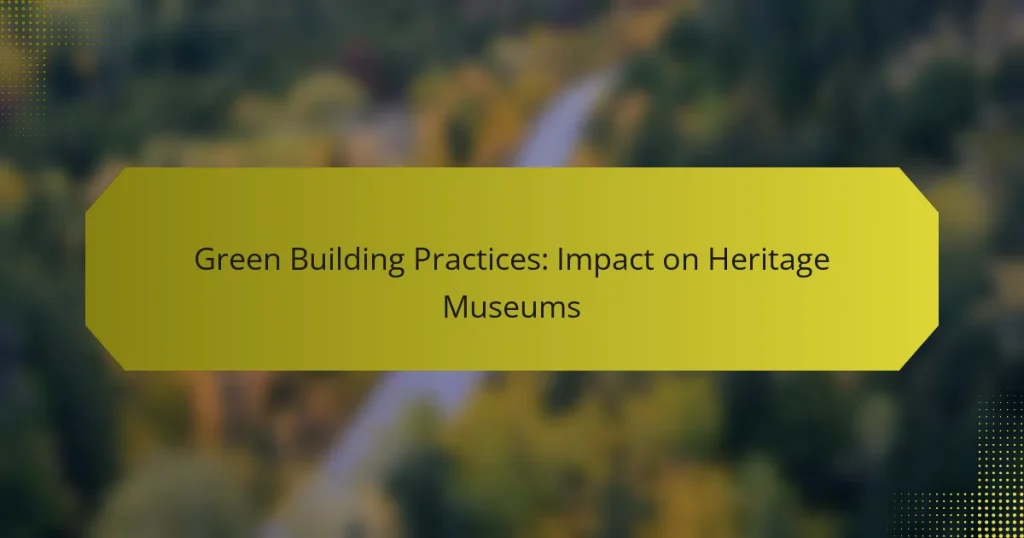World heritage museums are increasingly embracing sustainability initiatives to minimize their environmental footprint and foster conservation efforts. By integrating energy-efficient systems and engaging with local communities, these institutions aim to balance the preservation of cultural heritage with the urgent need to combat climate change.
Waste Management Practices: Evaluation in World Heritage Museums
Community Involvement: Role in Museum Sustainability Efforts
Sustainable Sourcing: Importance for Museum Exhibits
Carbon Footprint Reduction Strategies: Comparison Across Museums
Green Building Practices: Impact on Heritage Museums
How are world heritage museums implementing sustainability initiatives?
World heritage museums are adopting various sustainability initiatives to reduce their environmental impact and promote conservation. These initiatives range from energy-efficient systems to community engagement, reflecting a commitment to preserving cultural heritage while addressing climate change.
Energy-efficient lighting systems
Many world heritage museums are upgrading to energy-efficient lighting systems, such as LED technology, which can reduce energy consumption by up to 75% compared to traditional incandescent bulbs. These systems not only lower electricity costs but also minimize heat output, protecting sensitive artifacts from damage.
Implementing smart lighting controls, such as motion sensors and timers, further enhances energy savings by ensuring lights are only on when needed. Museums can also consider natural lighting solutions, which can reduce reliance on artificial sources during daylight hours.
Water conservation practices
Water conservation is a critical aspect of sustainability in world heritage museums. Many institutions are installing low-flow fixtures and rainwater harvesting systems to significantly reduce water usage. These measures can lead to savings of 20-30% in water consumption.
Additionally, museums are adopting drought-resistant landscaping and efficient irrigation systems to minimize water waste in outdoor areas. Regular maintenance and monitoring help ensure these systems operate effectively and sustainably.
Waste reduction programs
Waste reduction programs are essential for minimizing the environmental footprint of world heritage museums. Many museums are implementing recycling and composting initiatives to divert waste from landfills. This can lead to a reduction of waste by 50% or more when effectively managed.
Educating staff and visitors about proper waste disposal and recycling practices is crucial for the success of these programs. Museums can also collaborate with local organizations to promote zero-waste events and initiatives.
Green building certifications
Achieving green building certifications, such as LEED (Leadership in Energy and Environmental Design), is a goal for many world heritage museums. These certifications require adherence to strict sustainability standards in areas like energy efficiency, water conservation, and indoor environmental quality.
By pursuing these certifications, museums not only enhance their sustainability profile but also attract visitors interested in eco-friendly practices. The process often involves conducting energy audits and making necessary upgrades to meet certification criteria.
Community engagement in sustainability
Engaging the community in sustainability initiatives is vital for world heritage museums. Many institutions host workshops, educational programs, and volunteer opportunities to raise awareness about environmental issues and conservation efforts.
Collaborating with local schools and organizations can amplify these efforts, fostering a sense of shared responsibility for cultural and environmental preservation. Museums can also encourage visitors to participate in sustainability practices during their visits, creating a more impactful experience.
What are the benefits of sustainability initiatives in museums?
Sustainability initiatives in museums offer numerous advantages, including enhanced visitor engagement, reduced operational costs, and a stronger public image. By implementing eco-friendly practices, museums can attract more visitors while also benefiting financially and socially.
Enhanced visitor experience
Implementing sustainability initiatives can significantly improve the visitor experience by creating a more engaging and educational environment. For instance, interactive exhibits that showcase sustainable practices can captivate audiences and encourage them to think critically about environmental issues.
Additionally, museums that prioritize sustainability often feature green spaces and natural lighting, which enhance the overall ambiance. Visitors are likely to appreciate a museum that reflects their values regarding environmental stewardship.
Cost savings on utilities
Sustainability initiatives can lead to substantial cost savings on utilities through energy-efficient systems and water conservation measures. For example, switching to LED lighting and installing smart thermostats can reduce energy consumption by a significant percentage, leading to lower electricity bills.
Moreover, implementing rainwater harvesting systems can decrease water costs, especially in regions with high utility rates. These savings can be redirected towards educational programs or exhibit enhancements, maximizing the museum’s impact.
Improved public image
Adopting sustainability initiatives enhances a museum’s public image by demonstrating a commitment to environmental responsibility. This positive perception can attract environmentally conscious visitors and partners, fostering community support and engagement.
Furthermore, museums that actively promote their sustainability efforts can gain recognition through awards and certifications, which can further elevate their status within the cultural sector. A strong public image can lead to increased visitor numbers and stronger community ties.
Increased funding opportunities
Sustainability initiatives can open up new funding opportunities from government grants, private foundations, and corporate sponsorships focused on environmental projects. Many funding bodies prioritize support for organizations that demonstrate a commitment to sustainability and community impact.
Additionally, museums that showcase their sustainability efforts in grant applications can stand out among competitors, increasing their chances of securing financial support. Engaging with local businesses for sponsorship can also lead to mutually beneficial partnerships that enhance funding prospects.
Which world heritage museums are leading in sustainability?
Several world heritage museums are at the forefront of sustainability, implementing innovative practices to reduce their environmental impact. Notable examples include the Louvre Museum, the Smithsonian Institution, and the British Museum, each adopting unique strategies to promote eco-friendly operations.
The Louvre Museum’s eco-friendly practices
The Louvre Museum has made significant strides in sustainability by integrating energy-efficient technologies and sustainable materials into its operations. For instance, the museum has upgraded its lighting systems to LED, which can reduce energy consumption by up to 80% compared to traditional bulbs.
Additionally, the Louvre has implemented a comprehensive waste management program that emphasizes recycling and composting. This initiative not only minimizes landfill waste but also promotes awareness among visitors about the importance of sustainability.
Smithsonian Institution’s sustainability programs
The Smithsonian Institution has established a robust framework for sustainability, focusing on energy conservation, water efficiency, and sustainable transportation. The institution aims to achieve a 30% reduction in greenhouse gas emissions by 2025, utilizing renewable energy sources such as solar and wind power.
Moreover, the Smithsonian has developed educational programs that engage the public in sustainability efforts, encouraging visitors to adopt eco-friendly practices in their daily lives. This dual approach of operational efficiency and public engagement enhances the institution’s overall impact on environmental stewardship.
British Museum’s carbon reduction efforts
The British Museum is committed to reducing its carbon footprint through various initiatives, including energy-efficient building upgrades and sustainable exhibition practices. The museum has set a target to achieve net-zero carbon emissions by 2030, which involves transitioning to renewable energy sources and optimizing energy use across its facilities.
In addition to infrastructure improvements, the British Museum actively participates in community outreach programs that promote sustainability. These programs aim to educate visitors about the museum’s efforts and inspire them to consider their own environmental impact.
What frameworks guide sustainability in museums?
Sustainability in museums is guided by various frameworks that provide structured approaches to environmental stewardship and resource management. These frameworks help museums implement practices that minimize their ecological footprint while enhancing visitor experiences and preserving cultural heritage.
UNESCO’s sustainability guidelines
UNESCO offers a set of sustainability guidelines aimed at helping museums integrate environmental considerations into their operations. These guidelines emphasize the importance of cultural heritage preservation alongside sustainable development, encouraging museums to adopt practices that support both ecological and cultural sustainability.
For example, museums are encouraged to engage in community outreach and education programs that promote awareness of sustainability issues. Implementing energy-efficient technologies and sustainable materials in exhibitions and facilities are also recommended practices.
ISO 14001 environmental management standards
ISO 14001 is an internationally recognized standard that outlines the criteria for an effective environmental management system (EMS). Museums adopting this standard can systematically improve their environmental performance by identifying and managing their environmental impacts.
Key steps include conducting regular audits, setting measurable objectives, and ensuring staff training on sustainability practices. Museums can benefit from adopting ISO 14001 by enhancing their reputation, reducing costs through efficient resource use, and meeting regulatory requirements.
How can museums measure the impact of sustainability initiatives?
Museums can measure the impact of sustainability initiatives through various methods, including carbon footprint assessments and visitor feedback surveys. These approaches provide valuable insights into the effectiveness of eco-friendly practices and help identify areas for improvement.
Carbon footprint assessments
Carbon footprint assessments involve calculating the total greenhouse gas emissions produced by a museum’s operations. This includes energy consumption, waste generation, and transportation. By using established frameworks such as the Greenhouse Gas Protocol, museums can obtain a clear picture of their environmental impact.
To conduct an assessment, museums should gather data on energy use, waste disposal, and visitor transport patterns. This information can be analyzed to identify major emission sources and prioritize reduction strategies. Regular assessments allow for tracking progress over time and adjusting initiatives as needed.
Visitor feedback surveys
Visitor feedback surveys are essential for understanding how sustainability initiatives resonate with the public. These surveys can gauge visitor awareness and attitudes towards eco-friendly practices implemented by the museum. Questions may focus on perceived importance, satisfaction with sustainability efforts, and suggestions for improvement.
To maximize response rates, museums should keep surveys concise and accessible, offering both online and in-person options. Analyzing the feedback can reveal trends and preferences, helping museums tailor their sustainability initiatives to better align with visitor expectations and enhance overall engagement.





